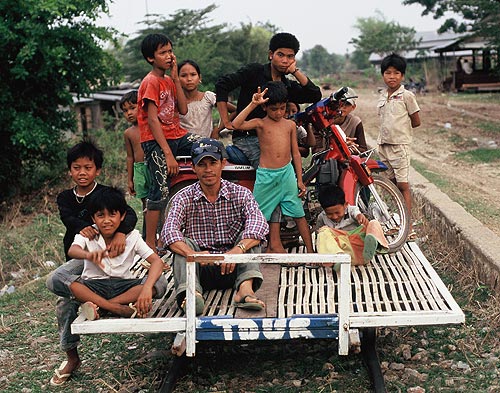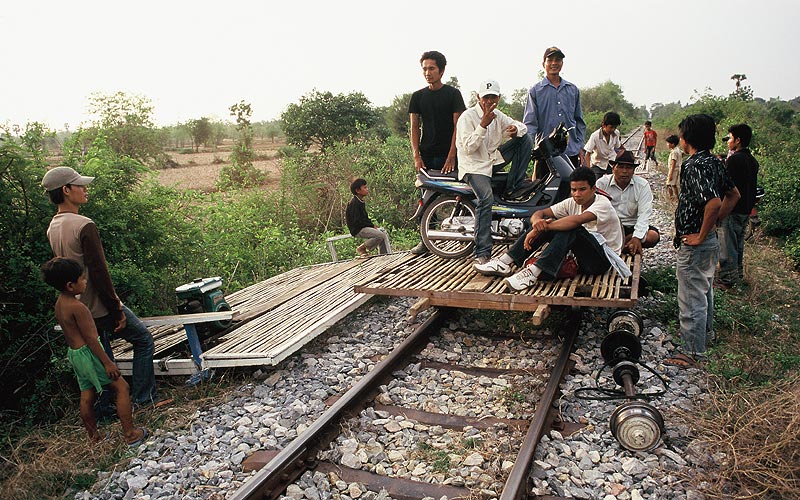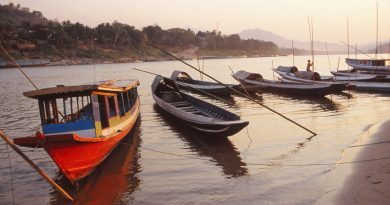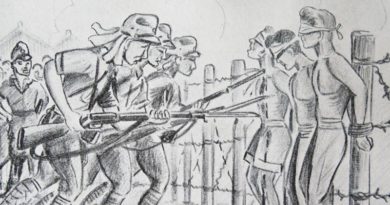Riding the bamboo train
Forget the Trans-Siberian.
Forget the Orient Express and New Zealand’s own Tranz Alpine.
If you want a truly memorable rail experience — one that’ll set you back just a few dollars and won’t involve staring at frozen tundra for a week — look no further than the Battambang bamboo train.
Battambang is Cambodia’s sleepy second city. It has none of the sleaze and traffic jams of the capital, Phnom Penh, or the touts and rip-offs of Angkor Wat.
What it does have is a decaying, French-built railway network that sees at most one train a day. The tracks are poorly maintained and the trains excruciatingly slow, so the locals get around by truck. Once the government finishes sealing the highways, the trains may disappear altogether.

But the Cambodians are natural entrepreneurs, eager to make up for decades lost to war and the Khmer Rouge. So an opportunity like an idle railway track is not going to be ignored.
I enlisted Chai, a cheerful “moto” driver, to help me track down a bamboo train. Cambodia has no city buses and few taxis, so short-distance travel is done on the back of a motor scooter.
The Cambodians are masters of this form of transport — it’s not unusual to see five people on a scooter, balancing babies and pots of soup while weaving through rush-hour traffic.
I knew Chai was well used to foreigners by the way he slowed down at corners and kept both hands on the handlebars, most of the time. But I did feel nervous when he drove with his eyes closed to keep out the clouds of red dust.
After a series of detours — a hilltop temple, a “killing cave” piled with bones, palm-thatch villages where tourists are greeted like rock stars — we finally came to a railway crossing.
A forlorn station was crumbling next to a narrow-gauge track and a cluster of bamboo huts. The train drivers had already called it a day. Things weren’t looking hopeful.
But ten minutes later Chai reappeared, looking very pleased with himself. A little negotiation and US$4 later, I had chartered my very own bamboo train.

The bamboo train — or norry, as the locals call it — is as ingenious as it is simple. A platform of split bamboo, measuring roughly 2m by 4m, rests on a pair of steel-wheeled axles. An old fan belt is looped around the rear axle and driven by a two-stroke motor, just big enough to power a lawnmower. The axles slot loosely into notches sawn into the platform’s wooden frame, so only the passengers’ weight stops the whole contraption flying apart.
Chai explained that norries used to be propelled with bamboo poles, much like punting a boat along a canal. But when the country opened up a decade ago, Cambodians were able to buy motors across the border in Thailand. Overnight a plodding, human-powered platform turned into a bamboo rocket.
By the time Leng, our norry driver, had assembled the craft, a dozen kids had climbed aboard for the ride. Chai’s scooter was hoisted on board as well, making a fairly crowded, and boisterous, train.
The bigger boys gave the norry a push start and we were soon clattering down the buckled tracks at impressive speed. A bamboo train can hit 50km/h, which feels fast when there’s little to hang onto and the rails haven’t been repaired in decades. I was ducking branches and clinging on over jury-rigged bridges, when a thought occurred: What happens if another norry or, God forbid, a real train comes the other way?
Right on cue, a dot appeared on the tracks ahead. It was rapidly approaching norry. It was then I realised that a bamboo train has no brakes — all the driver can do is turn off the motor and hope it coasts to a stop in time.
I needn’t have worried about a collision, but the problem of another norry blocking the tracks remained.

A battle of wills ensued. Tense minutes passed, until Leng grudgingly backed down. It seems bamboo trains observe a sort of give-way protocol: The norry carrying the greatest number of passengers, scooters or livestock has right of way.
We all piled off and watched as Leng dismantled his norry and rebuilt it in just under two minutes. The fan belt was slipped off, the platform lifted clear and the axles picked up off the rails. As soon as the other norry had chugged past, the process was reversed and we were on our way again.
Three times we encountered a norry coming the other way; twice we lost. You could tell Leng dismantled and rebuilt his train dozens of times a day.
Leng dropped Chai and me at the outskirts of Battambang, where he flipped the platform around and clattered home with his norry-load of children.
Our trip on the bamboo train had lasted little more than an hour, covered at most 20km and shown us only rice paddies, squalid villages and water buffalo. But I’d rate it one of the great train journeys of the world.




